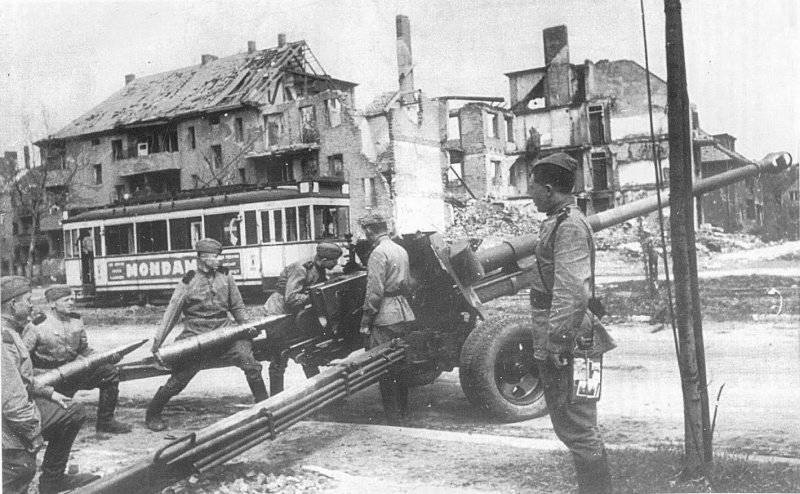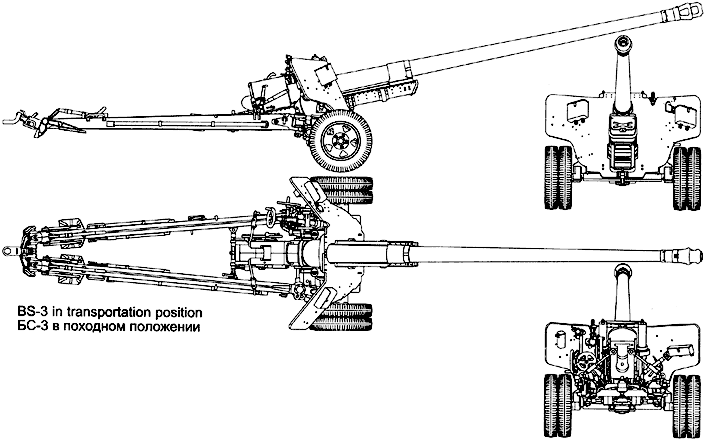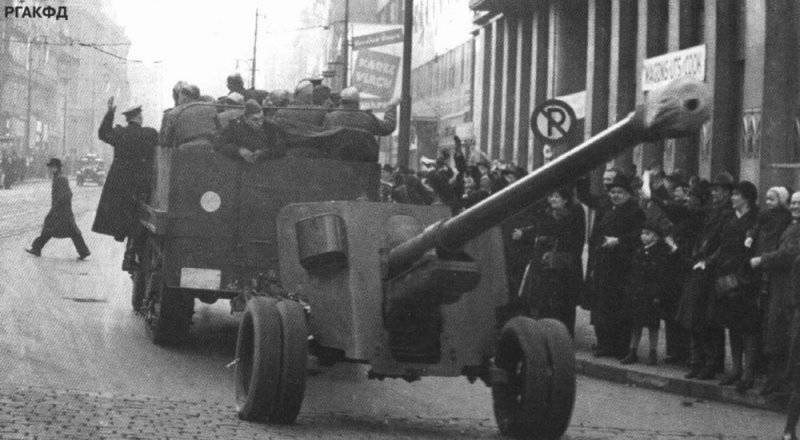BS-100 3 mm field gun

The structure of the barrel of the gun includes: monoblock pipe, breech, rear and front clips, clutch and muzzle brake. The two-chamber muzzle brake has an efficiency of around 60 percent. Vertical wedge gate with semiautomatic copying (mechanical) type. The gun is equipped with a hydraulic recoil brake and hydropneumatic knurler. The recoil cylinders roll back with a barrel during a shot. The cradle is trough-shaped riveted. In the cradle installed recoil device. Swivel screw mechanism. The lifting mechanism is two-sector. The balancing mechanism of the pushing type, hydropneumatic, consists of a pair of parallel operating cylinders.
Suspension torsion. It turned on / off automatically during the information / dilution of the bed. The wheels from the GAZ-AA truck had a reinforced rubber tire and a special wheel hub. The gun was transported without a front end. For its transportation used tractors I-12 and AT-L, an armored personnel carrier M-2 and a ZIS-151 vehicle.
Sights: panorama C-71-5 and optical sight OP1-5 for direct fire. In the guns of the first editions of the direct-sight sight was absent.
Ammunition:
High-explosive fragmentation shell OF-412:
Shots - 3UOF412 / 3UOF412U;
Projectile weight - 15,6 kg;
The mass of explosive - 1,46 kg;
Initial speed - 900 m / s;
Direct shot range - 1100 m;
The maximum firing range - 20 th. M.
Fragment grenade O-412:
Shot - PP-412;
Projectile weight - 15,94 kg;
Initial speed - 898 m / s;
Maximum firing range - 21,36 thousand m;
Direct shot range - 1,2 th. M.
Armor-piercing shells of BR-412, BR-412B, BR-412D:
Выстрелы – УБР-412/3УБР3/3УБР412Д;
Projectile weight - 15,088 kg;
Explosive weight - 0,06 kg;
Initial speed - 895 m / s;
Direct shot range - 1040 / 1070 m;
The maximum firing range - 4 th. M.
Armor-piercing piercing projectiles 3BM25 and 3BM8:
Shot –3UBM11 and 3UBM6.
Projectile weight - 5,7 kg.
Cumulative armor-piercing shells 3БК17, 3БК5:
Shot - 3UBK9 and 3UBK4.
High-explosive fragmentation shell OF-32 (1980-s):
Shot - 3UOF10 / 3UOFXNNXX;
Projectile weight - 15,6 kg;
Explosive mass - 1,7kg;
Direct shot firing range - 1100 m;
The maximum firing range - 20600 m.
Controlled anti-tank missile 9М117 complex "Bastion":
Shot - 3UBK10-1;
Firing range - 100-4000 meters;
Penetration - under 60 degrees - 275 mm, at an angle 90 degrees - 550 mm.

It is intended to destroy openly located and sheltered (in trenches, trenches) manpower, including body armor, and openly located unarmoured vehicles.
In the post-war years, the BS-3 cannon was subjected to a small modernization, which primarily concerned ammunition and sights. Prior to the beginning of the 1960's. BS-3 guns successfully penetrated the armor of any Western-made tank. However, later the situation changed: the BS-3 sub-caliber armor-piercing shells were unable to penetrate the frontal armor of the turret, as well as the upper frontal armor of the Chiften, M-48А2 and M-60 tanks. Therefore, urgently developed cumulative and sub-caliber shells were developed and adopted. Moreover, the sabot shells were able to penetrate any armor of the M-48А2 tank, as well as the towers of the Chiften and M-60 tanks, but did not penetrate the upper frontal armor of these tanks. Cumulative shells were able to penetrate any armor of all three armored vehicles.
In the 1980's, the BS-100 3-millimeter cannon entered the 9М117 anti-tank projectile (the Bastion missile system), the effective firing range of which left 100 to 4000 meters and pierced 550-millimeter meters. However, their troops received little.
Technical characteristics of BS-100 3 mm field gun:
The mass of the gun in the combat position - 3650 kg;
Bore caliber - 100 mm;
Barrel length - 5960 mm / 59,6 gauges;
The height of the line of fire - 1010 mm;
The number of grooves - 40;
Gun dimensions in the stowed position:
- length - 9370 mm;
- height - mm 1500;
- width - 2150 mm;
Firing range:
- OF-412 and OFS - 20 thousand m;
- RP-32 - 20,6 thousand m;
- direct shot - 1070 m;
Rate of fire - up to 10 shots per minute;
The angle of horizontal guidance - 58 degrees;
The angle of vertical guidance is from -5 to + 45 degrees;
Ammunition - BS, DS, OS, OFS.
Charging - unitary.
Sights:
- OP1-5 - optical sight;
- С71А-5 - mechanical sight (panorama);
Maximum towing speed - 50 km / h;
Calculation - 6 people.


Information